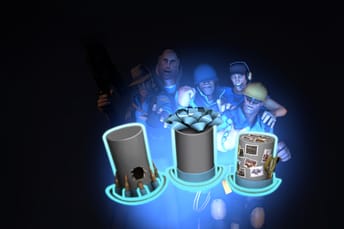
Marathon Without Runners: Bungie’s Struggle to Find an Audience
|
|
If you’ve ever wondered how a live service game launches with no clear audience—you’re not alone. Bungie’s Marathon is coming out this fall as a live service extraction shooter. It is a premium game with no official price yet, but most popular rumors point to a 40$ price tag.
After playing the alpha, I kept circling back to the same question I asked myself after seeing the announcement almost two years ago: Who is this game for, and where will Bungie find enough concurrent players to keep its servers alive? I’ve already written a separate article on the extraction shooter genre, so here we’ll focus on the challenges of the live service part.

Saturated Market of Live Service Games
The real challenge for new PvP games in 2025
In this day and age, you can’t just conjure an audience out of thin air for a new game as a service (GaaS) title. And yes, while extraction shooters feature PvE content, they are primarily PvP titles, because fights between players are what usually determines whether you survive and keep your loot or you don’t. The market is oversaturated with PvP shooters. Players already have clear expectations and preferences, so new games need to be instantly engaging and offer something brand new at the same time to stand a chance.
Players’ time is limited, usually enough to play one or two games on a regular basis, and maybe a few others they jump into occasionally, though this also heavily depends on each game’s update cycle. Participation in events, leveling up the battle passes, grinding for new items, and checking out fresh content—all fueled by the almighty fear of missing out (FOMO)—you can’t farm everything everywhere; you have to set priorities.
Marathon’s goals
Marathon has to achieve two crucial objectives: take players away from already established titles and find whatever niche is still left open. To see how viable that is, I’m going to compare Marathon with the closest games design-wise (or game modes, like Call of Duty’s DMZ extraction mode). The main way I’ll categorize these games is by their payment model (F2P or premium games, mostly B2P), also taking a brief look at their genre (extraction shooter or other kinds of PvP shooters), and their availability on consoles. There will be some exceptions, and we’ll also look at Destiny 2 at the end, because it’s a Bungie game and happens to be the one I have the most to say about.
Also, for every game I mention here, I’ve spent different time playing them (just for reference, I have over three thousand hours in both Destiny 2 and Escape from Tarkov, not counting time spent in orbit or in the stash, respectively). Everything else got less playtime, but I still put in somewhere between a few dozen and a few hundred hours into most titles mentioned below. Let’s proceed and see what Bungie and Sony are betting on for Marathon’s long-term survival.
Marathon vs Premium Shooters
Escape from Tarkov (EFT)
Battlestate Games’ PvPvE shooter drops players into Russian suburbs where every gun, bullet, and consumable is something you can lose forever in a brutal experience of an extraction shooter. Deep ballistics system, limb-based damage, complex weapon modding, and real players alongside unusually smart AI enemies create a tense gameplay loop that rewards map knowledge, meticulous planning, and an understanding of the in-game economy, not just pure reflexes. It is self-described as a Hazardous Environment Combat Simulator (HECS).
Since its 2017 beta, the game has grown through seasonal wipes and new locations, and received a pure PvE game mode. Optimization, server stability, and cheating remain the pain points (but it’s a lot better than it was a few years ago). The game is semi-regularly supported with new content and balancing updates, and is available only on PC.
Marathon vs Tarkov
While Marathon doesn’t aim to match the depth or mil-sim authenticity of Escape from Tarkov, it could offer a smoother experience and serve as a more casual, low-stakes alternative for Tarkov players looking to take a break from exhausting events or long wipes.
However, there’s a real question of whether those same players will be willing to pay for Marathon just to shoot generic guns, when free Apex Legends and Call of Duty: Warzone with DMZ are readily available (and that’s not even counting other premium and free mil-sims).
In Marathon, the loot itself often feels meaningless, with one item or resource barely distinguishable from another except for color differences, unlike in EFT, where every item is a recognizable object with a purpose. On top of that, Marathon’s UESC enemies lack the unpredictability and personality that Tarkov’s Scavs bring to every gunfight.
Therefore, Marathon will mostly miss Tarkov’s audience.

Hunt: Showdown 1896
Crytek’s extraction shooter pits small squads of hunters against eldritch bosses and each other. Wild West setting with supernatural horror, permadeath of hunters with persistent bloodline progression, and a 19th-century arsenal give Hunt its original style, distinct from standard military shooters.
Seven years of updates have expanded the roster of maps, guns, and bosses, brought performance improvements, and live-story events with unique unlocks and temporary map versions or limited-time game modes. Its cult following praises the atmosphere, though the deliberate pacing keeps the audience smaller than run-and-gun shooters. Additionally, the game is available on consoles.
Marathon vs Hunt
One important factor that could attract Hunt players to Marathon is strong world-building. While the tone and setting are very different (dark Weird West vs colorful sci-fi dystopia), both games put a heavy focus on creating an immersive universe. For players who value this, Marathon might offer a new but equally fascinating setting to explore.
Compared to Tarkov, now we have the opposite problem—Hunt barely has a loot system in the typical extraction shooter sense. Items are straightforward, with immediate in-game use, and players spend little to no time managing inventories. As a result, Marathon’s item abundance could easily overwhelm someone coming from Hunt.
Moreover, the time-to-kill (TTK) in Hunt and Marathon is fundamentally different. Hunt uses a single health bar (divided into segments, with several mechanics tied to it), and a headshot from almost any gun can instantly down a player, creating a high-tension environment where every shot counts. In contrast, Marathon features a standard two-bar health and shield system, with a more moderate TTK overall; players can usually survive the first few shots, potentially leading to longer gunfights and more opportunities to react. If Hunt players wanted a forgiving shield mechanic, they would already be playing Apex or Warzone instead.
In the end, compared to Tarkov, Hunt players might be slightly more likely to buy and try Marathon. But will anything actually keep them playing it in the long run? That depends on whether Bungie can deliver on its promise to expand the game’s world after launch.
EVE Vanguard
CCP’s upcoming extraction shooter extends EVE Online’s sandbox to planetary war zones. Matches supply resources that flow back into the space MMO’s economy, promising a rare FPS-to-MMO feedback loop. Infantry fits, orbital artillery, and corporate contracts aim to replicate EVE’s emergent politics on foot. A console release is also planned for the game.
You might ask: Why even mention an unreleased game here? I participated in two beta tests (which were only available through a subscription), and there are a few similarities. First, the basic idea behind the shooter—clones, sci-fi setting, and so on. Second, some gameplay mechanics, mostly related to augmentations.
There’s a fair chance that EVE Vanguard could end up sharing the same fate as Dust 514, so for players who enjoy it, trying out Marathon would make a lot of sense. The only problem is that EVE as a whole is currently struggling with its player base.
Tom Clancy’s The Division franchise—Dark Zone & Survival
Ubisoft’s MMO grafted the extraction genre onto its core looter shooter mechanics back in 2016. The Dark Zone mixed PvE farm with volatile PvP fights, forcing players to extract contaminated loot amid tense standoffs. Survival PvPvE mode (released later in 2016 as part of the first DLC) dropped agents into a blizzard with no gear and a ticking infection timer. Players had to find warm clothing, medicine, and weapons, make their way into the Dark Zone through a hostile city, survive the encounter with Hunters, and evacuate—all while facing the constant threat of PvP. A successful evacuation rewarded players with loot for the main game. Every mode is available on consoles, too.

Part of the bigger game
Both modes won praise for raising stakes inside a broader MMO framework, yet since Survival was tied to The Division’s active player base, matchmaking suffered as soon as most players moved on to the sequel and other games. The Dark Zone in The Division 2 never felt as good as in the first game—probably because it was split into three smaller areas instead of one large, unified zone.
Still, these game modes proved that AAA publishers could successfully experiment with high-risk gameplay loops—even if it happened by accident, as it did with Ubisoft. Most of The Division’s 1 and 2 audience was there for the looter shooter experience, and once they got bored due to a lack of new content, they likely moved on to other games—possibly even Destiny 2 (just like I did).
What purpose does this example serve? To show that extraction-style modes can work well alongside a bigger core game, because they’re tied to the in-game economy and appeal to a smaller audience. Those who enjoyed the Dark Zone and Survival modes have likely moved on to other games, but in theory, they might still find Marathon interesting.
Other lesser-known extraction games
- The Cycle: Frontier, by Yager (servers closed)
- Scavengers, by Midwinter Entertainment (servers closed)
- Level Zero: Extraction, by Doghowl Games (post-launch support came to an end)
- Ascendant, by Ascendant Studios (coming soon)
- ARC Raiders, by Embark Studios (coming soon)
The reason behind this list (which could be expanded significantly, by the way) is to show that Marathon won’t be the only one competing for players. And if a live service game fails to attract an audience, offer something original, or address the genre’s key issues (balance, cheaters, and server stability), it may struggle to survive unless the publisher commits to long-term support.
Marathon vs Free-to-Play Shooters
Apex Legends
Available on consoles, EA’s hero shooter isn’t an extraction title, but when the Marathon gameplay was shown, it initially demonstrated noticeable similarity to Respawn’s battle royale. The game has a lot in common with Marathon: three-player squads, a health-and-shield system with comparable time-to-kill, slick movement, and a hero-based class system.
Marathon vs Apex
But there are issues. Marathon essentially plays like Apex at 0.66x speed. It also features far fewer heroes. And, speculatively, Marathon’s monetization might go beyond just cosmetics, based on my experience with Destiny.
Even with Apex having been in a bit of a decline over the past year, I don’t see the Apex audience spending money on Marathon, unless some console players specifically want to experience the extraction shooter genre but never had the chance due to the genre’s low representation on consoles. If, for some reason, they never tried Hunt or free DMZ, that is.
Call of Duty: Warzone—DMZ
Developed by Infinity Ward and Raven Software, published by Activision, DMZ drops trios onto a few different maps with faction missions, weapon cases, and raid-level bosses. It officially left beta and ended content support simultaneously at the end of 2023. Still, the game offers console players the most polished extraction experience available for free. DMZ also gained popularity because, for a while, the free-to-play audience had no other modes available to level up their weapons, and doing so in battle royale wasn’t very convenient.
Marathon vs DMZ
The contract system and map design in DMZ are very similar to Marathon. Both games share a similar content structure and core extraction gameplay loop. However, Marathon is expected to bring something new with a much higher risk, a slower overall pace, and a stronger focus on sci-fi aesthetics.
I can understand that console players who enjoyed DMZ might be interested in trying Marathon, but they’ll have to pay for less content and less polished systems. There are also rumors about a DMZ 2, but nothing of substance so far. And someone at Bungie might want to think about why DMZ’s development was frozen in the first place.
Delta Force—Operations
Operations is a free-to-play extraction shooter mode featured in Delta Force. Players form squads, choose operators (surface-level hero system), deploy into large open maps, complete contracts, collect high-value loot, and fight both AI enemies and other players, aiming to extract safely. Successful extractions reward players with gear and resources for future missions and permanent progression. Delta Force plans for a console release this summer.
From my impressions, Marathon overall feels most similar to Operations, with all its strengths and weaknesses. Once again, I can see players wanting to try this kind of experience on consoles, but I don’t see that “killer feature” that would make them stay in Marathon for long, if we haven’t seen any original gameplay mechanics, while rocking a (presumably) 40$ price tag.
Other titles
- Vigor—a free-to-play third-person extraction shooter set in post-apocalyptic Norway, available on both PC and consoles
- Gray Zone Warfare—a tactical PvPvE shooter focused on realism, PC only
- Arena Breakout: Infinite—basically, Tarkov’s clone. PC and mobile devices
Free-to-play extraction shooters have already built strong audiences, and Marathon will have to compete for players who are used to accessing similar experiences for free. Convincing them to invest in a premium game, especially one with potentially less content and polish at launch, will be a major challenge.
Marathon vs Destiny 2
Now we come to the centerpiece of the discussion: Bungie’s flagship title, Destiny 2. It is a live service looter shooter built around a seasonal content model. Its primary focus is on PvE experience, offering story campaigns, seasonal activities, strikes, dungeons, and raids. The game also features a few PvP modes in Crucible and Gambit, fully dedicated to PvEvP.
PvE audience
But what part of the Destiny 2 player base is going to play Marathon? The majority of Destiny 2’s players are focused on PvE and have little to no interest in competitive PvP. Needless to say that in an extraction shooter, every match is competitive because you’re competing over valuable loot. I see both familiar faces and random D2 fans online who are willing to buy Marathon at least to explore a new and intriguing world—after all, the Marathon IP hasn’t seen a new entry in almost 30 years. But they’ll literally have to bite the bullet (and probably more than one) just to discover what secrets are hidden within Tau Ceti IV, and after the alpha, the enthusiasm started to fade.
PvP audience
PvP players, on the other hand, likely won’t care much about extraction economy systems—but they won’t need to, since they can simply dominate weaker players and take their loot. It usually triggers a feedback loop where players quickly burn out from constant losses and start quitting day by day, thus accelerating the game’s decline. It is pretty much common for any PvP title without a steady flow of new players.
PvPvE audience
That leaves a very narrow slice of the D2 community: the Gambit fans, who likely make up less than 10% of the active player base (based on Charlemagne stats). It’s a theoretical situation of Destiny 3 being announced, only for players to find out it was essentially a Gambit-only game—that is bound to mismatch with the expectations of the game’s essential audience. I personally gilded the Dredgen title eight or nine times before I eventually left Destiny 2 for good, so I’ve been waiting for more information about Marathon for the past two years.
Marathon’s Audience: Final Thoughts
Challenges of launching a new live service game
Marathon faces an uphill battle in an already saturated live service market. It must convince players, many of whom are already used to free-to-play experiences or heavily involved in other premium titles, to invest time in a B2P game with less content and fewer systems at launch.
Monetization will likely follow the usual live service model: DLCs, battle passes, and mostly cosmetic microtransactions. While that’s common today, it’s a much harder sell for a paid game. And given the nature of the genre, Marathon could even include paid quality-of-life upgrades like extra vault space. In a market already packed with free-to-play games, Marathon will have to work much harder to justify its price.

Bringing extraction shooters to consoles
Obviously, consoles have fewer extraction shooters and more room to expand into that niche. But perhaps consoles simply aren’t well-suited for traditional extraction shooter mechanics. Sorting through detailed inventories with a controller is slower and more cumbersome compared to a mouse and keyboard, and many core elements of the genre may feel out of place on platforms designed for more casual and accessible experiences.
This raises the real question: is the lower number of extraction shooters on consoles a gap to be filled, or a sign that the genre struggles to properly convert its experience and find a committed audience there?
Marathon alpha impressions
Marathon’s alpha didn’t showcase any truly new mechanics—all of its content felt like iterations on features from other games, which is disappointing. The only thing that shows real potential for uniqueness is its world-building. Understandably, certain issues present in the alpha will be addressed before launch, and I’m not focusing on those temporary problems.
Another problem with Marathon is that it plays like a battle royale: you can gear up your character with top-tier loot in a single match, while the ability to revive teammates quickly and for free from a body bag creates one more issue—there’s no fear of dying. As a result, PvP is highly competitive, and solo players are always at a disadvantage since three-player squads have no reason to hold back. And the matter of forced trios and the lack of a solo mode was already highlighted in my previous article about extraction shooters.
What concerns me more are the core mechanics, which are unlikely to change significantly on release, and honestly, they just feel mid. Put simply, it’s hard to justify paying for a game that offers no more than what many free titles already provide.
Marathon without runners
Game’s potential overlap with Destiny 2’s audience is slim: the majority of PvE-focused players might buy the game out of curiosity, but they are unlikely to engage with it consistently in long-term perspective; PvP players might show up for a while, only to eventually burn out or get bored and leave; and Gambit players represent too small a niche to sustain the game alone. Likewise, it’s a similar story with other games—none have a clear audience that Marathon can reliably pull from or retain.
With all that, Marathon risks repeating the familiar pattern of a sharp launch player spike followed by a rapid population decline. Building a successful extraction shooter is a long process filled with trial and error, often taking years—but does Bungie, now operating under Sony, actually have the time to pull it off?



